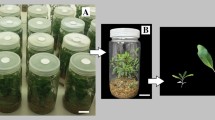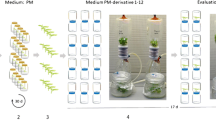Abstract
An efficient production system, which can quickly produce high quality plants, is shown in this study of Liquidambar styraciflua. The mini-cuttings technique was used for ex vitro clonal propagation of three sweetgum clones. The semi-hydroponics system for production of propagules was also tested, and the concentration of indole-3-butyric acid (IBA) for rooting was evaluated. Three adult clones, produced according to conventional cutting processes, were used as mini-stumps and maintained in semi-hydroponics systems of medium size sand. Ten collections of sprouts were prepared to evaluate the production of semi-hydroponics systems (mini-clonal hedges). Sprouts from collection number six were used at different concentrations of IBA solution (0; 500; 1,000; 3,000 and 6,000 mg l−1) to test the mini-cuttings technique. The high survival rates of mini-stumps after ten collections (96.3%), and high annual production per square meter (~2,953 mini-cuttings) showed that the mini-clonal hedges are viable to conduct sweetgum mini-stumps. The formation of 62.5% of healthy plants after hardening under outdoor conditions showed that sweetgum could be successfully propagated by the mini-cuttings technique.

Similar content being viewed by others
References
Alfenas AC, Zauza EAV, Mafia RG, Assis TF (2004) Clonagem e doenças de eucalipto. UFV, Viçosa
Arreghini RI, Riu NE, Bustamante JA (1996) Poplar mother stock: cuttings production at Rivadavia, Mendoza, Argentina. Rev Fac Cienc Agr 28:65–69
Assis TF, Mafia RG (2007) Hibridação e clonagem. In: Borém A (ed) Biotecnologia florestal. Suprema Gráfica, Viçosa, pp 93–121
Bilan MV (1974) Rooting of Liquidambar styraciflua cuttings. N Z J For Sci 4:177–180
Bonner FT (1963) Some southern hardwoods can be air-layered. J For 61:923
Brand MH, Lineberger RD (1988) In vitro adventitious shoot formation on mature-phase leaves and petioles of Liquidambar styraciflua L. Plant Sci 57:173–179
Brown CL, McAlpine RG (1964) Propagation of sweetgum from root cuttings. Ga For Res Counc 24:5
Dai J, Vendrame WA, Merkle SA (2004) Enhancing the productivity oh hybrid yellow-poplar and hybrid sweetgum embryogenic cultures. In Vitro Cell Dev Biol Plant 40:376–383
Ferreira BGA, Zuffellato-Ribas KC, Carpanezzi AA, Tavares FR, Boeger MRT, Koehler HS (2001) Enraizamento de Sapium glandulatum (Vell.) Pax. pela aplicação de ácido indol butírico e ácido bórico. Leandra 16:11–16
Gocke MH (2006) Production system influences the survival and morphology of rooted stem cuttings of loblolly pine (Pinus taeda L.) and sweetgum (Liquidambar styraciflua L.), Master of Science in Forestry, Graduate Faculty of North Carolina State University, Raleigh, 136 p
Gurgel Garrido LMA, Faria HH, Cruz SF, Palomo M (1997) Variabilidade genética de características silviculturais de Liquidambar styraciflua L em teste de origens em Paraguaçu Paulista - SP. Rev Inst Flor 9:125–132
Hamann A (1998) Adventitious root formation in cuttings of loblolly pine (Pinus taeda L.): developmental sequence and effects of maturation. Tree Physiol 12:175–180
Hare RC (1976) Rooting of american and formosan sweetgum cuttings taken from girdled and nongirdled cuttings. Tree Plant Not 27:6–7
Harlow WM, Harrar ES, Hardin JW, White FM (1996) Textbook of dendrology, 8th edn. McGraw-Hill, New York
Hartmann HT, Kester DE, Davies Junior FT, Geneve RL (2002) Plant propagation: principles and practices, 7th edn. Prentice-Hall, New Jersey
Kim MK, Sommer HE, Bongarten BC, Merkle SA (1997) High-frequency induction of adventitious shoots from hypocotyl segments of Liquidambar styraciflua L. by thidiazuron. Plant Cell Rep 16:536–540
Kormanik PP, Brown CL (1973) Modified growth chamber enhances vegetative propagation of selected sweetgum and yellow-poplar. In: Proceedings of 12th South Forest Tree Improvement Conference, pp 259–266
Lee N, Wetztein HY, Sommer HE (1985) Effect of quantum flux density on photosynthesis and chloroplast ultrastructure in tissue-cultured plantlets and seedlings of Liquidambar styraciflua L. towards improved acclimatization and field survival. Plant Physiol 78:637–641
Lee N, Wetztein HY, Sommer HE (1986) The effect of agar vs liquid medium on rooting in tissue-cultured sweetgum. HortSci 21:317–318
Malac BF, Heeren RD (1979) Hardwood plantation management. South J Appl For 3:3–6
McAlpine RG (1965) Vegetative propagation methods for hardwoods. In: Proceedings of 8th south forest tree improvement conference, pp 14–20
McCarter PS, Hughes CE (1984) Liquidambar styraciflua L—a species of potential for the tropics. Comm For Rev 63:207–216
McElwee RL (1970) Wood characteristics of three southern hardwood species and their relationship to pulping properties. Tappi J 53:1882–1886
Merkle SA, Bailey RL, Pauley BA, Neu KA, Kim MK, Rugh CL, Montello PM (1997) Somatic embryogenesis from tissues of mature sweetgum trees. Can J For Res 27:959–964
Muñoz VL (1992) Apuntes sobre algumas latifoliadas de madeiras valiosas 3—Liquidambar (Liquidambar styraciflua L.). Cienc Invest For 2:335–348
Neera S, Arakawa H, Ishimaru K (1993) Tannin production in cell cultures of Liquidambar styraciflua. Phytochemistry 32:921–924
Rieckermann H, Goldfarb B, Cunningham MW, Kellison RC (1999) Influence of nitrogen, photoperiod, cutting type, and clone on root and shoot development of rooted stem cuttings of sweetgum. New For 18:231–244
Robert E, Farmer Jr (1966) Propagation of sweetgum by softwood stem cuttings. In: Proceedings of the 8th south forest tree improvement conference, pp 123–124
Schwambach J, Ruedell CM, Almeida MR, Penchel RM, Araújo EF, Fett-Neto AG (2008) Adventitious rooting of Eucalyptus globulus × maidennii mini-cuttings derived from mini-stumps grown in sand bed and intermittent flooding trays: a comparative study. New For 36:261–271
Shimizu JY, Spir IHZ (1999) Avaliação de procedências e progênies de liquidâmbar da América Central, do México e dos Estados Unidos, em Agudos, Brasil. Bol Pesq Flor 39:93–108
Shimizu JY, Spir IHZ (2002) Produtividade de madeira de liquidâmbar de diferentes procedências em Quedas do Iguaçu, PR. Bol Pesq Flor 44:3–12
Sommer HE, Brown CL (1980) Embryogenesis in tissue cultures of sweetgum. For Sci 26:257–260
Sutter EG, Barker PB (1985) In vitro propagation of mature Liquidambar styraciflua. Plant Cell Tissue Organ Cult 5:13–21
Taiz L, Zeiger E (2004) Plant physiology, 3rd edn. Sinauer Associates, Sunderland
Tennant D (1975) A test of a modified line intersect method of estimating root length. J Ecol 63:995–1001
Titon M, Xavier A, Otoni WC, Reis GG (2003) Efeito do AIB no enraizamento de miniestacas e microestacas de clones de Eucalyptus grandis W Hill ex Maiden. Rev Árvore 27:1–7
Titon M, Xavier A, Otoni WC (2006) Clonal propagation of Eucalyptus grandis using the mini-cutting and micro-cutting techniques. Sci For 71:109–117
Vendrame WA, Holliday CP, Merkle SA (2001) Clonal propagation of hybrid sweetgum (Liquidambar styraciflua × L formosa) by somatic embryogenesis. Plant Cell Rep 20:691–695
Wendling I, Dutra LF, Grossi F (2007) Sistema semi-hidropônico para condução de minicepas de erva-mate (Ilex paraguariensis St Hil.) e miniestaquia. Pesq Agropec Bras 42:289–292
Wetztein HY, Sommer HE (1983) Scanning electron microscopy of in vitro-cultured Liquidambar styraciflua plantlets during acclimatization. J Am Soc Hortic Sci 108:475–480
Xavier A, Santos GA, Oliveira ML (2003) Enraizamento de miniestaca caulinar e foliar na propagação vegetativa de cedro-rosa (Cedrela fissilis Vell.). Rev Árvore 27:351–356
Acknowledgments
This study was financed by EMBRAPA and the Ministry of Agriculture of Brazil. We thank anonymous reviewers for critical comments on the manuscript. G. E. B. is thankful to the CNPq for his scholarship.
Author information
Authors and Affiliations
Corresponding author
Rights and permissions
About this article
Cite this article
Wendling, I., Brondani, G.E., Dutra, L.F. et al. Mini-cuttings technique: a new ex vitro method for clonal propagation of sweetgum. New Forests 39, 343–353 (2010). https://doi.org/10.1007/s11056-009-9175-2
Received:
Accepted:
Published:
Issue Date:
DOI: https://doi.org/10.1007/s11056-009-9175-2




